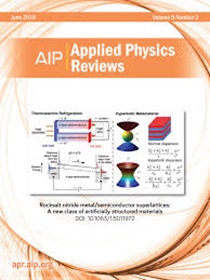电池材料的光发射光谱
IF 11.9
1区 物理与天体物理
Q1 PHYSICS, APPLIED
引用次数: 0
摘要
获得2019年诺贝尔化学奖的可充电锂离子电池(LIB)已成为一项具有世界革命性的技术。基于锂离子电池和“超越锂离子电池”在容量、循环寿命和安全性方面的进一步发展与对电极和电解质的化学成分、结构、物理性质以及其他相关组件的基本理解密切相关。在电池运行过程中发生的动态过程的时间演化快照可以帮助设计更好的策略,以防止不受控制的间相层的形成、树突、电极/电解质分解和气体的产生。光发射光谱(PES)已成为了解上述方面的重要技术之一。然而,在PES测量期间,从样品制备到数据分析,需要考虑许多潜在的陷阱和注意事项。虽然本文的主要重点不是评估PES技术本身,但我们首先介绍了一组最小的基本概念,以尽量减少PES物理引起的误解。随后,我们研究了利用PES技术确定固态和液态电池材料化学成分的研究,连接PES和电化学之间不同术语的能级图,以及PES从第一性原理计算到机器学习的理论方面。在本文的最后,我们概述了未来可能的研究方向。本文章由计算机程序翻译,如有差异,请以英文原文为准。
Photoemission spectroscopy of battery materials
Recognized by the 2019 Nobel Prize in Chemistry, rechargeable lithium-ion battery (LIB) has become a world-revolutionary technology. Further developments of LIB-based and “beyond LIBs” regarding capacity, cycle life, and safety are intimately associated with the fundamental understanding of chemical compositions, structures, physical properties of electrodes and electrolytes, and other related components. The time-evolving snapshots of the dynamical processes occurring during the battery operation can help design better strategies to prevent the formation of uncontrolled interphase layers, dendrites, electrode/electrolyte decompositions, and generation of gases. Photoemission spectroscopy (PES) has become one of the important techniques for understanding the aforementioned aspects. However, many potential pitfalls and cautions need to be considered from sample preparation, during PES measurements, to data analyses. Although the primary focus of this article is not to evaluate the PES technique itself, we first introduce a minimal set of fundamental concepts to minimize misinterpretation arising from the physics of PES. Subsequently, we examine studies that utilize PES techniques to determine chemical compositions of solid- and liquid-state battery materials, energy level diagrams that bridge different terminologies between PES and electrochemistry, along with the theoretical aspects of PES evolving from first-principle calculations to machine learning. Toward the end of this review, we outline potential future research directions.
求助全文
通过发布文献求助,成功后即可免费获取论文全文。
去求助
来源期刊

Applied physics reviews
PHYSICS, APPLIED-
CiteScore
22.50
自引率
2.00%
发文量
113
审稿时长
2 months
期刊介绍:
Applied Physics Reviews (APR) is a journal featuring articles on critical topics in experimental or theoretical research in applied physics and applications of physics to other scientific and engineering branches. The publication includes two main types of articles:
Original Research: These articles report on high-quality, novel research studies that are of significant interest to the applied physics community.
Reviews: Review articles in APR can either be authoritative and comprehensive assessments of established areas of applied physics or short, timely reviews of recent advances in established fields or emerging areas of applied physics.
 求助内容:
求助内容: 应助结果提醒方式:
应助结果提醒方式:


